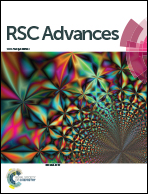Dual off–on and on–off fluorescent detection of Zn2+/Cd2+ ions based on carbazolone substituted 2-aminobenzamides†
Abstract
Two new 2-aminobenzamide structural isomers, 4-isoACOBA and 5-isoACOBA, as fluorescent probes for Cd2+ and Zn2+ were fabricated with carbazolone as fluorophore and N,N-bis(2-pyridylmethyl)ethylenediamine (BPEA) as chelator. With Cd2+/Zn2+ as input, the two probes are characteristic of the transformation from “off–on” to “on–off” molecular switch by interchanging the substitution position of the fluorophore from C-4 to C-5 at the benzene ring. 4-IsoACOBA is a Cd2+-specific turn-on fluorescent probe exhibiting good discrimination between Cd2+ and Zn2+ with FCd2+/FZn2+ = 2.48, while 5-isoACOBA is a Zn2+-specific turn-off probe with FCd2+/FZn2+ = 4.50. The binding behaviours of 4-isoACOBA–Cd(II) and 5-isoACOBA–Zn(II) were deeply investigated by UV and fluorescence titration, ESI-MS analysis, and DFT study. The results indicate that both the electron donating/withdrawing ability and the substituted position of the fluorophore have remarkable influences on the probe sensing properties and selectivity.


 Please wait while we load your content...
Please wait while we load your content...